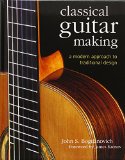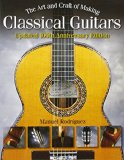What you will need
1. The first thing you will need is a book on the subject and I recommend two. The first is Classical Guitar Construction by Irving Sloane. This is a simple and straightforward book that takes you through the process. It also includes a template for all the parts of the guitar. The second book is considered the bible of guitar construction and it is: Guitarmaking: Tradition and Technology: A Complete Reference for the Design & Construction of the Steel-String Folk Guitar & the Classical Guitar (Guitar Reference) by William Cumpiano which is a much more complete reference that will also show you how to make folk guitars.
2. You must purchase, pre-made, some of the basic items for the guitar. These are the tuning pegs and the bridge. You will also need to purchase fret wire, purfling, the mosaic inlay, and a selection of wood both used directly in the guitar and indirectly for the forms and jigs that are used to make the guitar.
3. Tools needed. A half dozen hand tools will be needed to make your guitar and these include a plane, block saw, hand scraper, several chisels, jigsaw wire cutters, several clamps, a power drill, and a 6 inch circle cutter. The books explain all the tools needed.
The Basic Assembly process
The first step in building a classical guitar entails building the forms and jigs. You can’t just build a guitar out of wood. It has to be shaped in a very particular way and to achieve this shape you have to build forms to shape it around. In particular, the curved sides of the guitar have to have a profile that exactly matches the shape of the soundboard and the backboard. You also create a jig that will hold the whole guitar together when you glue it into a complete whole.
The second step entails individually making the five major parts of the guitar. They are the neck/head, left side, right side, Soundboard, and backboard. Note that the neck/head assembly can be done in one piece or as two pieces assembled together.
The third step is where you would assemble and glue the five major pieces of the guitar together.
The Final Step is the finishing of the guitar. This includes inserting the frets on the neck, the purfling around the edges, and the sanding and varnishing of the guitar.
What is the most difficult part?
When curving the sides of the guitar you have to soak them in water and then heat them so they can be slowly shaped to the correct curvature. This takes some practice but you don’t have to guess at the shape. You make a jig that you use as a guide for a perfect fit. If you want to avoid this step you can purchase kits with the sides already pre-bent.
A little bit about the wood
The wood you use is of the utmost importance when it comes to how your guitar will sound. And Brazilian rosewood is the wood of choice for most classical guitars. But there are variations on this such as Spanish Cypress, which is often used for Spanish guitars. Other woods used are maple, birch, pear and mahogany.
Don’t think you have the skill to do it all yourself?
There are many online dealers that will sell complete kits that have everything pre-cut and shaped correctly. All you have to do is assemble it and finish it. This is a good alternative if you don’t think you want to tackle the whole project. You can also buy kits that have all the selections of wood uncut and raw so you can still do all the crafting.
Making your own classical guitar can be a challenge and it takes patience and some handy skills but it definitely something the average do it yourself person can accomplish. And the reward is a musical instrument that will be your lifetime companion.
 Classical Guitar Making: A Modern Approach to Traditional Design Classical Guitar Making: A Modern Approach to Traditional Design
What a thrill for any musician: playing a fine-sounding instrument that he or she has lovingly crafted from scratch. With this richly illustrated manual, well-known luthier and guitarist John Bogdanovich shows exactly how to build that first, beautiful guitar, using traditional, time-tested methods. All that's required are basic woodworking techniques and a minimally equipped shop. Bogdanovich discusses the anatomy of the guitar, sound, choosing an instrument, selecting woods, templates and molds, and preparation. In more than 300 pages of text, he painstakingly lays out the details of construction, from assembling the neck and sides to installing the fingerboard and bridge.

The Art and Craft of Making Classical Guitars
(Guitar Reference). 100th anniversary updated edition! Rich in beauty, sound, and history, Manuel Rodriguez and Sons' classical and flamenco guitars have been handcrafted in Madrid since 1909, and the company's creations are still acclaimed today. This book presents master luthier Manuel Rodriguez's thoughts on the history of the instrument he loved, including how the guitar attained its prominent position among musical instruments. Filled with fabulous historical photos, memorabilia, and more, this book is essential for all admirers of the guitar. A special new section on "Music with World Leaders," sponsored by the King of Spain, promotes the importance of music for children and much more.
|
![]()





